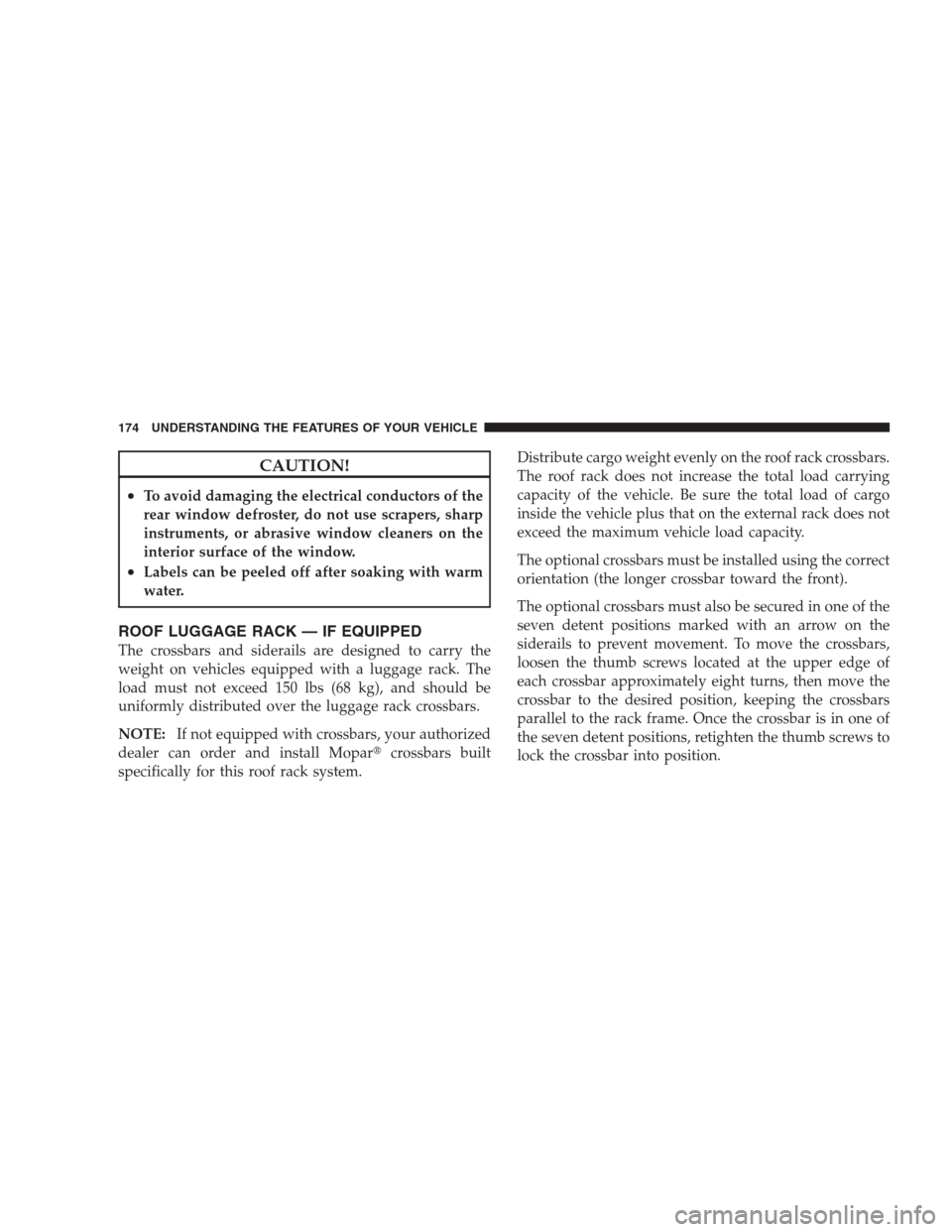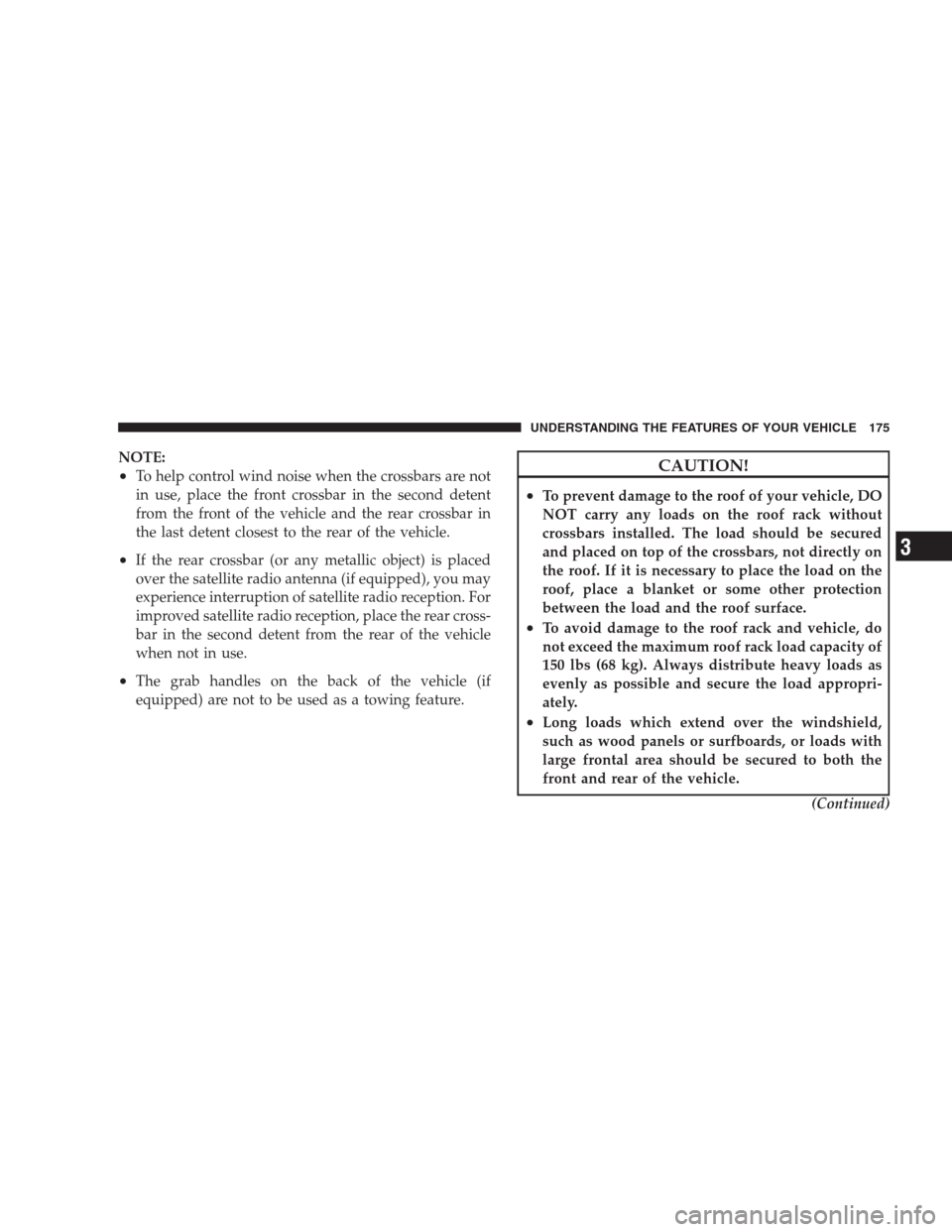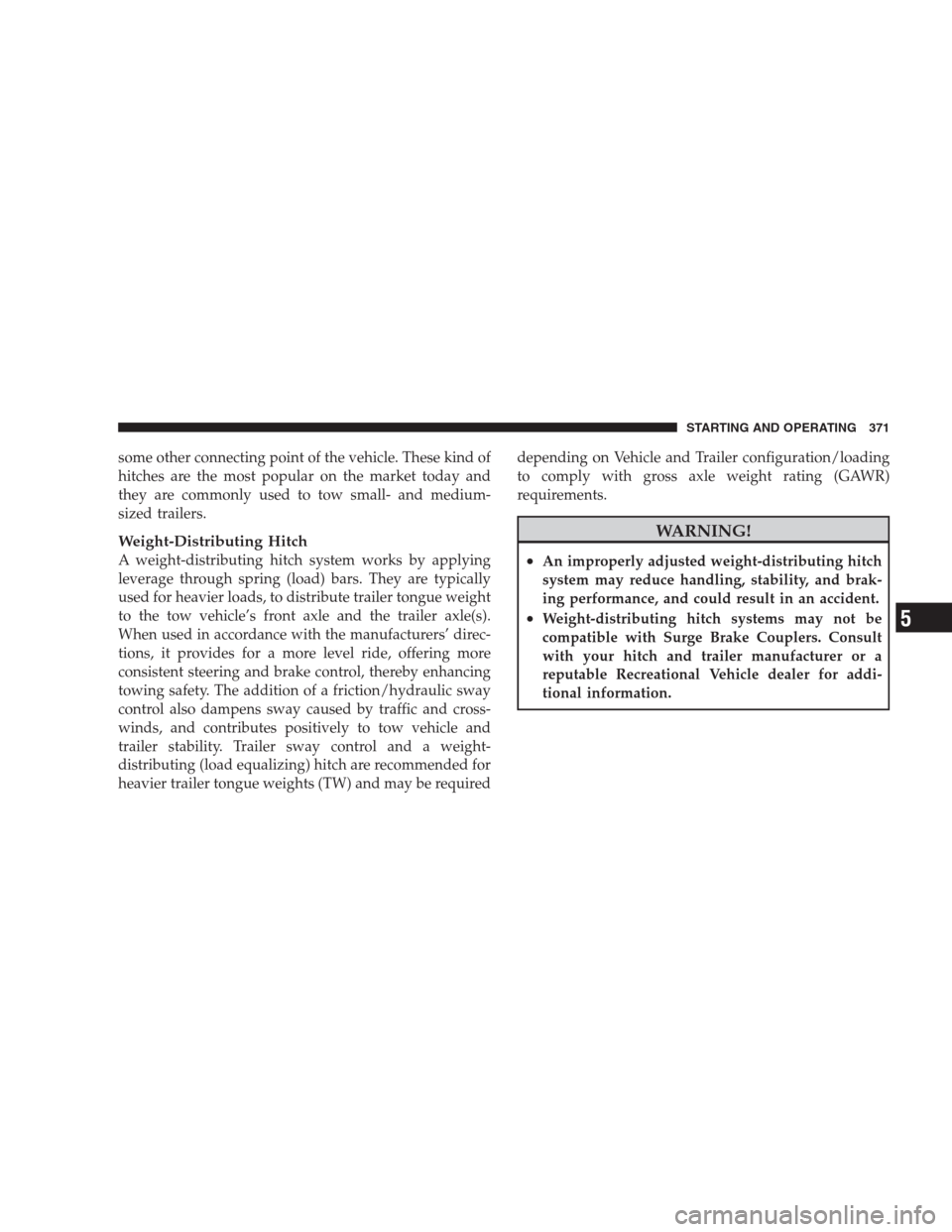Page 176 of 521

CAUTION!
•To avoid damaging the electrical conductors of the
rear window defroster, do not use scrapers, sharp
instruments, or abrasive window cleaners on the
interior surface of the window.
•Labels can be peeled off after soaking with warm
water.
ROOF LUGGAGE RACK — IF EQUIPPED
The crossbars and siderails are designed to carry the
weight on vehicles equipped with a luggage rack. The
load must not exceed 150 lbs (68 kg), and should be
uniformly distributed over the luggage rack crossbars.
NOTE:If not equipped with crossbars, your authorized
dealer can order and install Mopar�crossbars built
specifically for this roof rack system.Distribute cargo weight evenly on the roof rack crossbars.
The roof rack does not increase the total load carrying
capacity of the vehicle. Be sure the total load of cargo
inside the vehicle plus that on the external rack does not
exceed the maximum vehicle load capacity.
The optional crossbars must be installed using the correct
orientation (the longer crossbar toward the front).
The optional crossbars must also be secured in one of the
seven detent positions marked with an arrow on the
siderails to prevent movement. To move the crossbars,
loosen the thumb screws located at the upper edge of
each crossbar approximately eight turns, then move the
crossbar to the desired position, keeping the crossbars
parallel to the rack frame. Once the crossbar is in one of
the seven detent positions, retighten the thumb screws to
lock the crossbar into position.
174 UNDERSTANDING THE FEATURES OF YOUR VEHICLE
Page 177 of 521

NOTE:
•To help control wind noise when the crossbars are not
in use, place the front crossbar in the second detent
from the front of the vehicle and the rear crossbar in
the last detent closest to the rear of the vehicle.
•If the rear crossbar (or any metallic object) is placed
over the satellite radio antenna (if equipped), you may
experience interruption of satellite radio reception. For
improved satellite radio reception, place the rear cross-
bar in the second detent from the rear of the vehicle
when not in use.
•The grab handles on the back of the vehicle (if
equipped) are not to be used as a towing feature.
CAUTION!
•To prevent damage to the roof of your vehicle, DO
NOT carry any loads on the roof rack without
crossbars installed. The load should be secured
and placed on top of the crossbars, not directly on
the roof. If it is necessary to place the load on the
roof, place a blanket or some other protection
between the load and the roof surface.
•To avoid damage to the roof rack and vehicle, do
not exceed the maximum roof rack load capacity of
150 lbs (68 kg). Always distribute heavy loads as
evenly as possible and secure the load appropri-
ately.
•Long loads which extend over the windshield,
such as wood panels or surfboards, or loads with
large frontal area should be secured to both the
front and rear of the vehicle.
(Continued)
UNDERSTANDING THE FEATURES OF YOUR VEHICLE 175
3
Page 373 of 521

some other connecting point of the vehicle. These kind of
hitches are the most popular on the market today and
they are commonly used to tow small- and medium-
sized trailers.
Weight-Distributing Hitch
A weight-distributing hitch system works by applying
leverage through spring (load) bars. They are typically
used for heavier loads, to distribute trailer tongue weight
to the tow vehicle’s front axle and the trailer axle(s).
When used in accordance with the manufacturers’ direc-
tions, it provides for a more level ride, offering more
consistent steering and brake control, thereby enhancing
towing safety. The addition of a friction/hydraulic sway
control also dampens sway caused by traffic and cross-
winds, and contributes positively to tow vehicle and
trailer stability. Trailer sway control and a weight-
distributing (load equalizing) hitch are recommended for
heavier trailer tongue weights (TW) and may be requireddepending on Vehicle and Trailer configuration/loading
to comply with gross axle weight rating (GAWR)
requirements.
WARNING!
•An improperly adjusted weight-distributing hitch
system may reduce handling, stability, and brak-
ing performance, and could result in an accident.
•Weight-distributing hitch systems may not be
compatible with Surge Brake Couplers. Consult
with your hitch and trailer manufacturer or a
reputable Recreational Vehicle dealer for addi-
tional information.
STARTING AND OPERATING 371
5
Page 387 of 521
9. Shift the transmission into PARK.
10. Place the ignition key in the OFF position, and
remove key.
11. Apply the parking brake.
12. Attach the vehicle to the tow vehicle with tow bar.
13. Release the parking brake.
CAUTION!
Transmission damage may occur if the transmission
is shifted into PARK with the transfer case in NEU-
TRAL and the engine running. With the transfer case
in NEUTRAL ensure that the engine is OFF prior to
shifting the transmission into PARK (refer to steps 7
and 8 above).
Shifting Out Of NEUTRAL
Use the following procedure to prepare your vehicle for
normal usage.
1. Depress the brake pedal.
2. Turn the ignition key ON, engine off.
3. Shift the transmission into NEUTRAL.
4. Shift the transfer case out of NEUTRAL.
STARTING AND OPERATING 385
5
Page 389 of 521
NOTE:When shifting out of transfer case NEUTRAL,
turning the engine OFF may be required to avoid gear
clash.
WARNING!
You or others could be injured if you leave the
vehicle unattended with the transfer case in the
NEUTRAL position without first fully engaging the
parking brake. The transfer case NEUTRAL position
disengages both the front and rear driveshafts from
the powertrain and will allow the vehicle to move
even if the transmission is in PARK. The parking
brake should always be applied when the driver is
not in the vehicle.
CAUTION!
Do not use a bumper-mounted clamp-on tow bar on
your vehicle. The bumper face bar will be damaged.
STARTING AND OPERATING 387
5